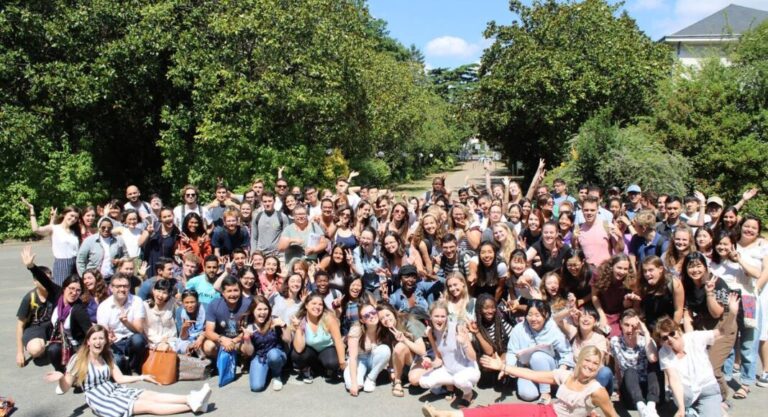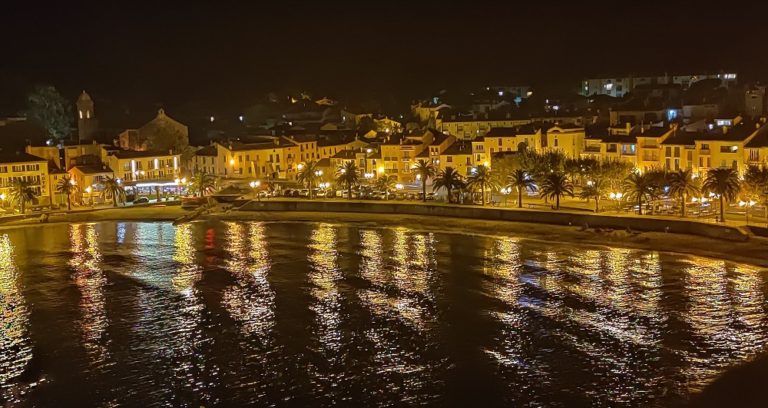Do you really know how to faire la bise in Marseille? In Lille? Which cheek do you start on? And how many times? This ritual and its name, “faire la bise,” can be incomprehensible to those who are unfamiliar with this “bisou” or “bécot,” so familiar and routine at the same time.
It’s to better explore this phenomenon that I decided to map it in my forthcoming book, “Parlez-vous [les] français ? Atlas des expressions de nos régions” (Armand Colin, October 2019). Thanks to an online survey system set up a few years ago, I was able to collect information from internet users about their use of French. This allowed me to clarify the area of extension and vitality of a number of linguistic regionalisms, and to examine, in a new light, the debate of “pain au chocolat vs. chocolatine.”
No, la bise is not “typically French”
The hypotheses on the origins of la bise are numerous, and often unverifiable. Is it the ritualization of ancestral behaviors, such as sniffing each other to recognize each other or reproducing an emotional expression related to childhood? On this point, historians, anthropologists and other specialists in human behavior have not reached a consensus. It’s said that faire la bise (or “se faire un schmoutz,” “se biser,” or “donner une baise”) is a habit that many Anglo-Saxons believe is typically French.
But it’s not: people also kiss each other in the countries in Southern Europe, in the Catholic or Orthodox tradition, in Russia, in some Arab countries and sub-Saharan Africa. Historically, it would seem that the ritual dates back to Antiquity, and that it has had its ups and downs in the history of modern humanity, sometimes prohibited, sometimes valued.
The question becomes even more complex when we try to take into account the context (saying hello, saying goodbye, wishing each other a happy new year, etc.), the family relationship of the people involved (la bise seems to have long been reserved for familial relations), or their gender. La bise between men has long been stigmatized.
La bise online
What is certain is that this ritual has been regularly stirring the internet for the past fifteen years or so. Part of the discussion is about the number of kisses given. The question first caused a buzz in 2003, following the launch of the combiendebises website.
The ritual also prompted British stand-up comedian and expat Paul Taylor to post a humorous video about it, which quickly won over audiences (more than three million views on YouTube).
The data we collected as part of our surveys conducted between 2016 and 2019 allowed us to provide new insights to continue the debate.
How many kisses?
Our first map was created using the responses of more than 18,600 internet users who reported having spent most of their youth in Belgium, France or Switzerland; and to whom the question “How many bises do you do to greet someone close to you?” Internet users were asked if they made one, two, three, four, or five or more kisses. We calculated the percentage of responses for each area in Belgium, France and Switzerland.
For each of these area, we used the answer that was most frequently the response:
y a cet excellent spectacle qui a provoqué une foule de visites sur un vieux billet du blog de ma carte des bises @ptcomedy – #FRANGLAIS | SPECTACLE COMPLET https://t.co/1dp6FhRsc1 j'ai refait la carte avec de nouvelles données pic.twitter.com/9Izo5FmV5k
— Mathieu Avanzi (@MathieuAvanzi) May 23, 2019
In Belgium, most internet users reported a single kiss (rates are around 100%), as in the northern part of the Finistère department (Morlaix and Brest, where rates are a little lower, 70%). It seems that the demands of the organization demanding la bise be a single kiss, Groupement de réhabilitation de l’usage de la bise unique, have been heard!
Mostly, the French give two kisses, except in Languedoc and in the southern part of the former Rhône-Alpes region. It’s a behavior that can be found in French-speaking Switzerland. In the northern part of France, the yellow areas indicate where there are still four kisses. However, analysis of the data shows that, in these regions, the four kisses are highly competitive with the two kisses. Kissing four times is a more common habit among older people than younger people. The future will tell us if the four kisses will continue to be reproduced in the years to come, or if they will become a distant memory.
The origin of these differences remains unknown. An internet user pointed out to me that the three kiss-region covered approximately the Protestant area of the 17th century, and that they would have been a sign of recognition of the Holy Trinity. For the four kisses, the idea would seem to be that everyone can kiss each other’s cheeks.
Which cheek is first?
The second debate concerns the cheek that should be turned first when you faire la bise. Of the just over 11,000 participants we interviewed, 15% of respondents admitted not knowing or replied both could be first. We excluded the responses of these participants, and generated the following map based on the remaining responses:
👨❤️💋👨💋la joue qu’on tend en premier quand on fait la bise #dimanchelinguistique pic.twitter.com/4lSTV8zW3G
— Mathieu Avanzi (@MathieuAvanzi) June 2, 2019
We can see that the territory is roughly divided into two parts. In southeastern and eastern France, the left cheek is turned first. In the other hemisphere, it is the right. However, it should be noted that there are two islets in each of these large regions: in the blue zone, French-speaking Switzerland stands out. In the brown zone, Haute-Normandie is the one that stands apart.
Again, it is difficult to explain the rationale for such a distribution, as the area drawn on the map does not correspond to any other known area that would explain it.
Variations on denominations
Finally, it is a less well-known fact, the way we call the act of faire la bise (and sometimes more generally, the act of faire un bisou to say hello or not) varies from one region to another. Our surveys allowed us to accurately map the area of seven regional verbs and expressions.
J'ai rédigé un petit article pour @FR_Conversation |en attendant sa mise en ligne, voici un petit aperçu d'une des cartes qu'il contient, et donc #spoiler, du sujet dont il traite| fil extrait de "Parlez-vous (les) français ?", en librairie ce mercredi 9 octobre @ArmandColin 👇👇 pic.twitter.com/UGNbIIjkDr
— Mathieu Avanzi (@MathieuAvanzi) October 6, 2019
Most of the words on this map belong to the same family as the contemporary French word “bise” (of which “bisou” is a derivative). The verb “se biser,” for example, has now emerged in conversational usage, but it is found in the writings of many early 20th-century authors (notably Raymond Queneau), and it still appears in some dictionaries (noted as a familiar term). It is still used in west-central France, where it coexists with the “se biger” variant, probably passed into regional French through the local dialects (Poitou, Angevin and/or Tourangeau) that were still commonly spoken by our ancestors a century ago.
In Belgium, “faire une baise à quelqu’un” is not sexual: the word “baise” corresponds to the noun “kiss” (we find it in the somewhat outdated word “baisemain”). The “baisse” variant, which is found in part of Picardy, is also related to the local form of the word for kiss in the dialects of this region.
The verb “se boujouter,” typical of Normandy, is built on the word “boujou,” which is the dialectal form of the French word “bonjour” in this region of France (so it’s nothing to do with the cheek).
In French-speaking Switzerland, the word “bec,” which is used in the expression “se faire un becquer,” is a phrase formed from the verb “becquer,” which is still used in French, and which essentially means “peck with the beak, then take by the beak.” We can compare “bec” to its equivalent in familiar French “bécot” (which also created the verb “bécotter,” “se faire des embous, s’embrasser amoureusement”).
As for the word “schmoutz,” which is found in the phrase ”se faire un schmoutz,” it is of German origin and means “bisou” in French (or “smacker” in English). It is exclusively used in the departments of France where Germanic dialects were still spoken for the most part at the beginning of the 20th century.
In a territory as large as that of the French-speaking world of Europe, it is not surprising that, from one region to another, the greetings, politeness or denominations of this or that object or action don’t go by the same name. In the past, in the days of our great-grandparents, dialects provided this community function. French has now taken over, but online social networks make it possible to highlight this beautiful diversity, much to the great pleasure of linguists.
This article was published in partnership with Le Point.
Featured image: Stock Photos from Iakov Filimonov /Shutterstock






